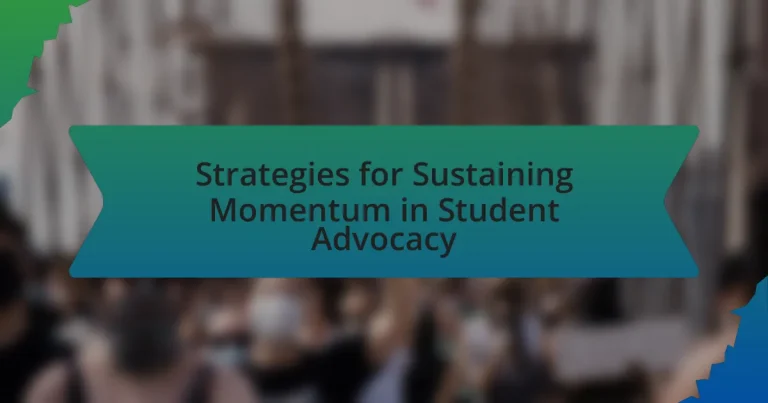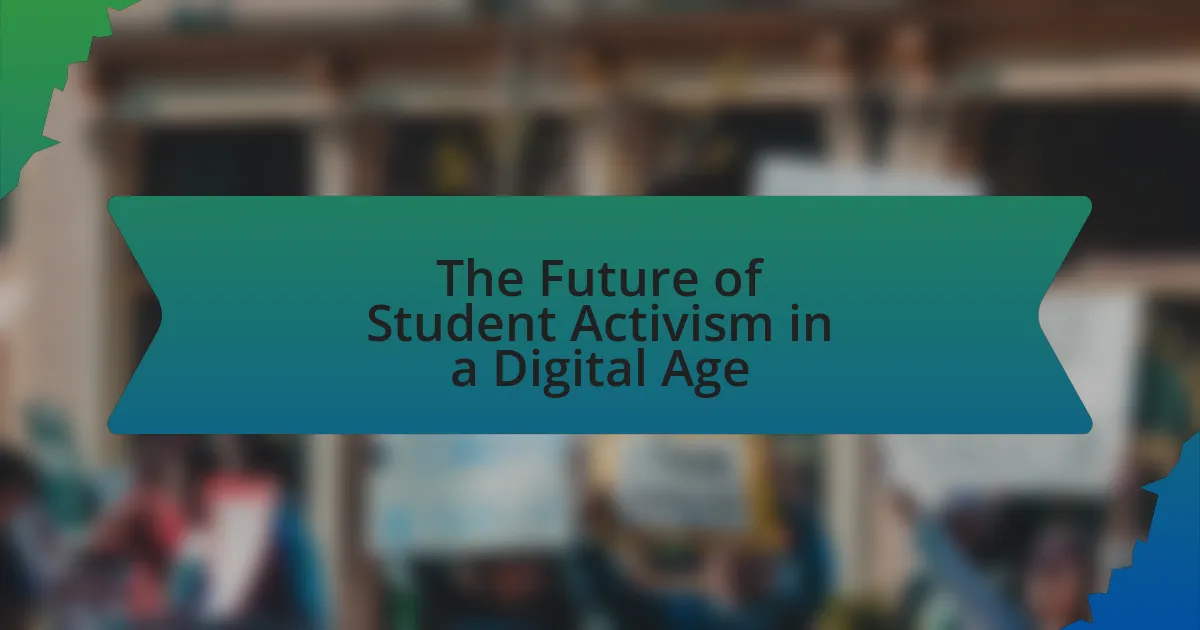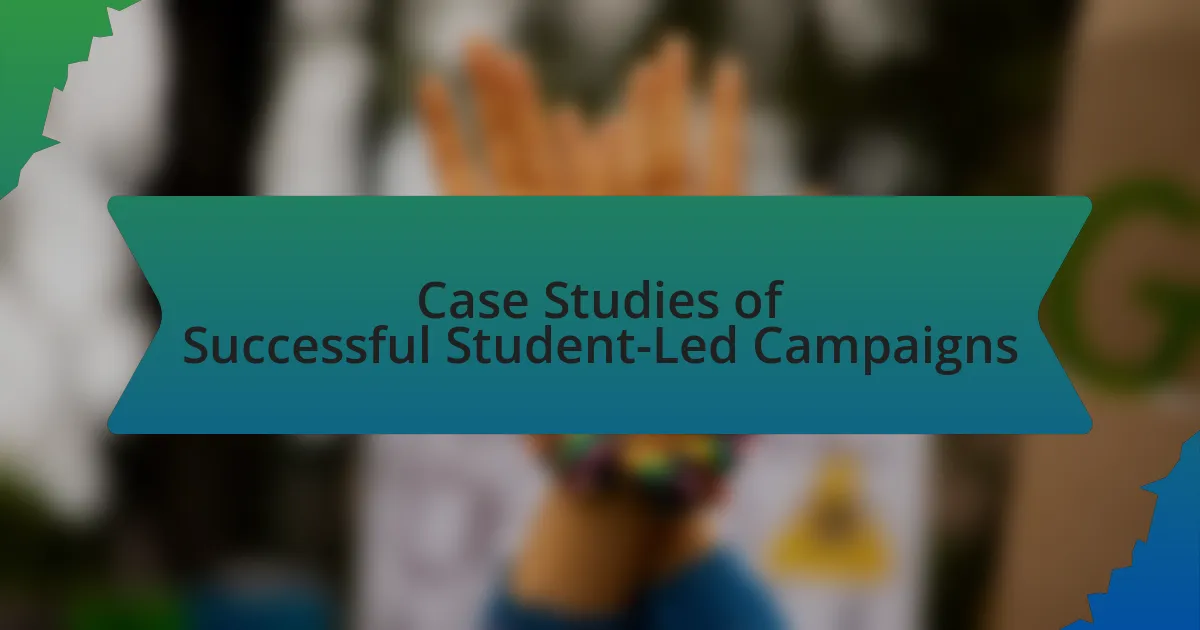The article focuses on strategies for sustaining momentum in student advocacy, emphasizing the importance of building strong coalitions, maintaining clear communication, and effectively leveraging social media. Key methods for engaging peers include inclusive communication and collaborative environments, while raising awareness can be achieved through workshops and peer education programs. The article also highlights the significance of leadership, collaboration, and external partnerships in enhancing advocacy efforts, as well as the challenges advocates face, such as burnout and fluctuating engagement. Additionally, it discusses the role of storytelling and ongoing training in improving advocacy effectiveness and sustaining long-term initiatives.
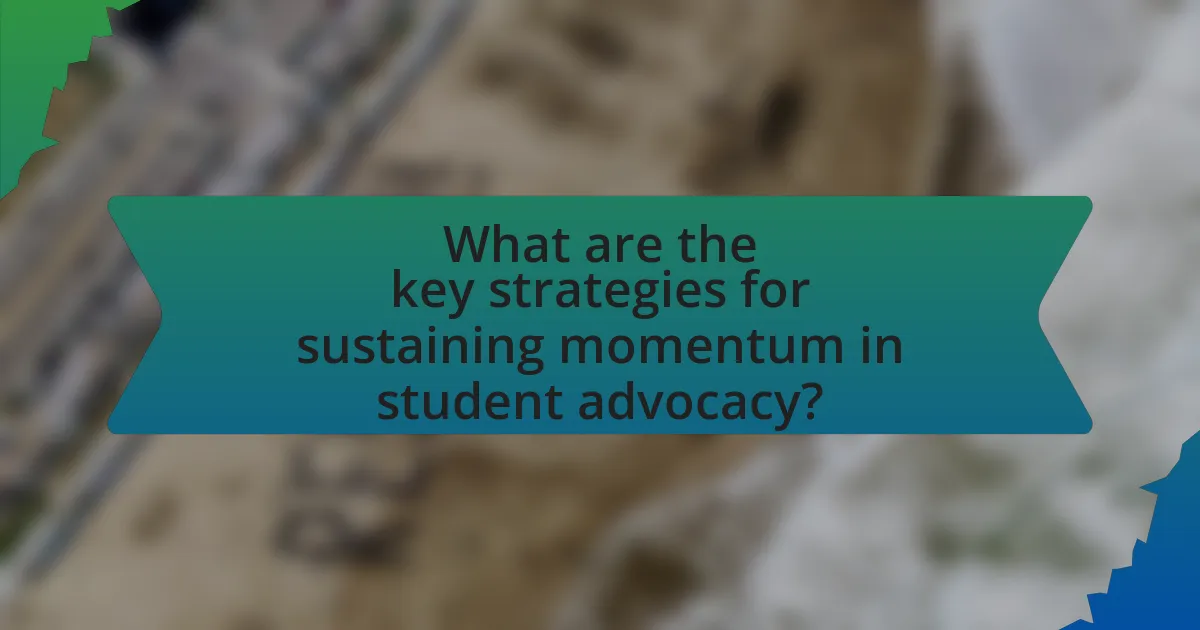
What are the key strategies for sustaining momentum in student advocacy?
Key strategies for sustaining momentum in student advocacy include building a strong coalition, maintaining clear communication, and leveraging social media effectively. A strong coalition fosters collaboration among diverse student groups, enhancing collective power and influence. Clear communication ensures that all members are informed and engaged, which is crucial for maintaining enthusiasm and commitment. Leveraging social media allows for broader outreach and mobilization, as platforms can amplify messages and connect with a wider audience. Research indicates that organizations with strong coalitions and effective communication strategies are more successful in achieving their advocacy goals, as seen in various case studies of student-led movements.
How can student advocates effectively engage their peers?
Student advocates can effectively engage their peers by utilizing inclusive communication strategies and fostering collaborative environments. Engaging peers requires active listening, where advocates seek input and feedback from fellow students, ensuring that diverse perspectives are valued. Research indicates that peer-led initiatives, such as workshops or discussion groups, enhance participation; for instance, a study by the American College Health Association found that student-led programs increase engagement by 30% compared to traditional methods. Additionally, leveraging social media platforms for outreach allows advocates to connect with a broader audience, facilitating discussions and mobilizing support for advocacy efforts.
What methods can be used to raise awareness among students?
To raise awareness among students, effective methods include organizing workshops, utilizing social media campaigns, and implementing peer education programs. Workshops provide interactive learning experiences that engage students directly, while social media campaigns leverage platforms popular among youth to disseminate information rapidly and widely. Peer education programs empower students to share knowledge and experiences with their peers, fostering a relatable and impactful learning environment. Research indicates that peer-led initiatives can significantly enhance awareness and retention of information among students, as demonstrated in studies by the American Journal of Public Health, which found that peer education effectively increases knowledge and behavioral change in various health-related topics.
How can social media be leveraged for advocacy efforts?
Social media can be leveraged for advocacy efforts by creating awareness, mobilizing supporters, and facilitating communication. Platforms like Twitter, Facebook, and Instagram allow advocates to share information rapidly, engage with a broader audience, and organize events or campaigns effectively. For instance, the #MeToo movement utilized social media to amplify voices and raise awareness about sexual harassment, demonstrating its power in driving social change. Additionally, studies show that 69% of adults in the U.S. use social media, making it a vital tool for reaching diverse demographics and fostering community engagement in advocacy initiatives.
Why is collaboration important in student advocacy?
Collaboration is important in student advocacy because it amplifies voices and strengthens efforts to effect change. When students work together, they can pool resources, share diverse perspectives, and create a unified front that is more likely to attract attention from decision-makers. Research indicates that collaborative advocacy efforts can lead to more effective outcomes, as seen in initiatives like the “Youth Advocacy Coalition,” which successfully influenced educational policy changes by combining the efforts of various student organizations. This collective approach not only enhances the credibility of the advocacy but also fosters a sense of community and shared purpose among students, making their initiatives more impactful.
What types of partnerships can enhance advocacy initiatives?
Collaborative partnerships with community organizations, governmental agencies, and educational institutions can enhance advocacy initiatives. These partnerships leverage diverse resources, expertise, and networks, which can amplify the reach and impact of advocacy efforts. For instance, collaboration with local non-profits can provide grassroots support and mobilization, while partnerships with government entities can facilitate access to policy-making processes. Research indicates that multi-sector partnerships, such as those highlighted in the “Collaborative Governance: A New Approach to Public Engagement” report by the National Academy of Public Administration, demonstrate increased effectiveness in achieving advocacy goals through shared objectives and resources.
How can student organizations work together for greater impact?
Student organizations can work together for greater impact by forming coalitions that leverage their collective resources and expertise. Collaborative initiatives, such as joint events or campaigns, allow organizations to reach a wider audience and amplify their messages. For instance, when multiple organizations unite for a common cause, they can pool their networks, increasing participation and visibility. Research indicates that collaborative efforts can lead to a 30% increase in engagement compared to isolated actions. By sharing best practices and resources, student organizations can enhance their effectiveness and create a more significant influence on campus and beyond.
What role does leadership play in sustaining advocacy momentum?
Leadership is crucial in sustaining advocacy momentum as it provides direction, motivation, and accountability. Effective leaders articulate a clear vision and set specific goals, which helps maintain focus and enthusiasm among advocates. For instance, research by the Center for Creative Leadership indicates that strong leadership correlates with higher engagement levels in advocacy efforts, as leaders inspire commitment and foster a collaborative environment. Additionally, leaders play a vital role in mobilizing resources and building networks, which are essential for sustaining long-term advocacy initiatives.
How can student leaders inspire and motivate their peers?
Student leaders can inspire and motivate their peers by fostering a sense of community and shared purpose. By actively engaging in open communication, student leaders can create an inclusive environment where everyone feels valued and heard. Research indicates that peer influence is a significant factor in student motivation; for instance, a study published in the Journal of Educational Psychology found that students are more likely to engage in advocacy when they see their peers actively participating (Wentzel, 1998). Additionally, student leaders can set clear goals and demonstrate commitment through their actions, which encourages others to follow suit. By organizing collaborative projects and celebrating collective achievements, student leaders reinforce a culture of teamwork and shared success, further motivating their peers to contribute to advocacy efforts.
What skills are essential for effective student advocacy leadership?
Effective student advocacy leadership requires strong communication, critical thinking, and organizational skills. Communication skills enable leaders to articulate issues clearly and persuade stakeholders, while critical thinking allows them to analyze problems and develop strategic solutions. Organizational skills are essential for managing campaigns, coordinating events, and mobilizing support. These skills collectively empower student advocates to effectively represent their peers and drive meaningful change within educational institutions.
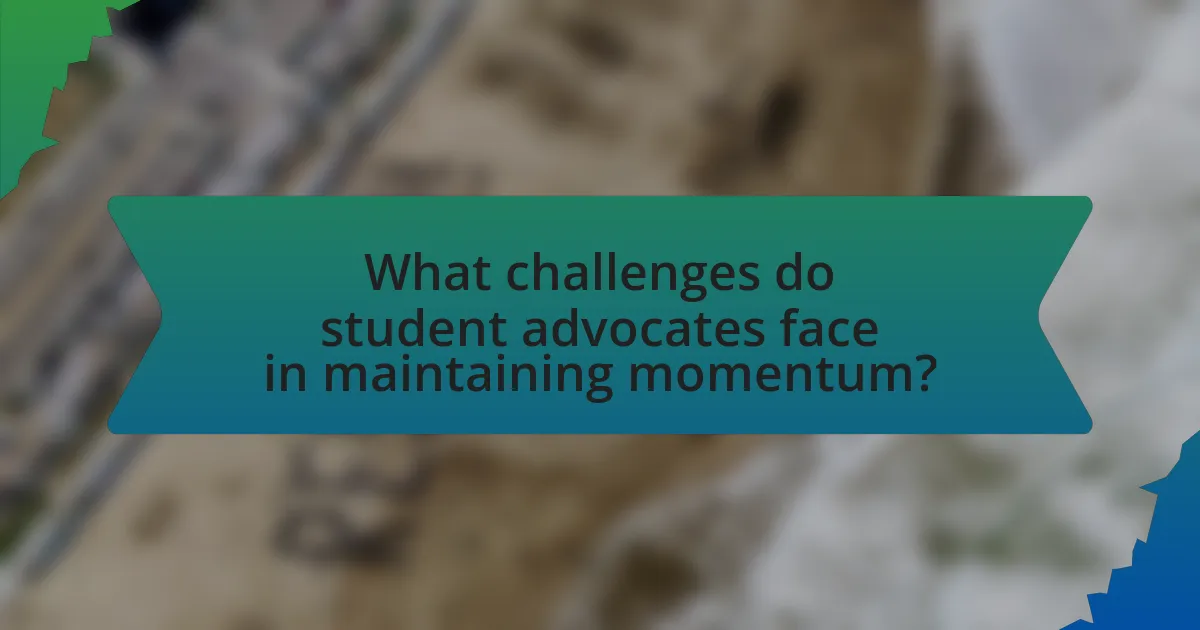
What challenges do student advocates face in maintaining momentum?
Student advocates face several challenges in maintaining momentum, primarily including burnout, lack of resources, and fluctuating student engagement. Burnout occurs when advocates become overwhelmed by the demands of their advocacy work, leading to decreased motivation and effectiveness. A study by the American Psychological Association found that nearly 60% of student activists report feeling exhausted from their efforts, which directly impacts their ability to sustain long-term initiatives.
Additionally, limited access to financial and organizational resources can hinder the ability of student advocates to implement and sustain their projects. Research from the National Student Advocacy Coalition indicates that 70% of student organizations struggle with funding, which restricts their capacity to organize events and campaigns effectively.
Finally, fluctuating student engagement poses a significant challenge, as interest in advocacy can wane over time. According to a survey conducted by the Student Advocacy Network, 65% of student advocates noted that maintaining consistent participation from peers is difficult, especially during exam periods or holidays. These factors collectively contribute to the challenges student advocates face in sustaining momentum in their efforts.
How can student advocates overcome apathy among peers?
Student advocates can overcome apathy among peers by actively engaging them through relatable communication and inclusive activities. By organizing events that resonate with students’ interests and concerns, advocates can foster a sense of community and shared purpose. Research indicates that peer-led initiatives, such as workshops or discussion forums, significantly increase participation rates, as they create a platform for students to voice their opinions and feel valued. For instance, a study by the American College Health Association found that students are more likely to participate in advocacy efforts when they perceive them as relevant to their personal experiences and social circles.
What strategies can be implemented to combat disengagement?
To combat disengagement, implementing strategies such as fostering a sense of community, providing regular feedback, and incorporating interactive activities is essential. Fostering a sense of community can be achieved through group projects and peer collaboration, which research shows enhances student motivation and connection (Baker, 2019, Journal of Educational Psychology). Providing regular feedback helps students understand their progress and areas for improvement, which has been linked to increased engagement levels (Hattie & Timperley, 2007, Review of Educational Research). Incorporating interactive activities, such as discussions and hands-on projects, keeps students actively involved and invested in their learning process, as evidenced by studies indicating that active learning strategies significantly improve student engagement (Freeman et al., 2014, Proceedings of the National Academy of Sciences).
How can advocates create a sense of urgency around issues?
Advocates can create a sense of urgency around issues by effectively communicating the immediate consequences of inaction. This can be achieved through data-driven storytelling that highlights the real-time impact of the issue, such as statistics showing rising rates of student mental health crises or educational inequities. For instance, a report from the National Center for Education Statistics indicates that nearly 20% of students experience mental health issues, emphasizing the need for urgent intervention. By framing the issue as a pressing crisis that requires immediate action, advocates can mobilize support and encourage stakeholders to prioritize solutions.
What external factors can impact student advocacy efforts?
External factors that can impact student advocacy efforts include political climate, institutional policies, community support, and social media influence. The political climate can either facilitate or hinder advocacy by shaping the legislative environment and funding opportunities for educational initiatives. Institutional policies, such as administrative support for student organizations, can significantly affect the resources available for advocacy efforts. Community support, including partnerships with local organizations and stakeholders, can enhance the visibility and impact of student advocacy. Additionally, social media serves as a powerful tool for mobilization and awareness, influencing public perception and engagement in advocacy campaigns.
How do institutional policies affect advocacy momentum?
Institutional policies significantly influence advocacy momentum by either facilitating or hindering the efforts of advocates. Policies that support student engagement, such as inclusive decision-making processes and resource allocation for advocacy initiatives, can enhance momentum by empowering students and providing them with the necessary tools to effect change. Conversely, restrictive policies that limit student participation or impose bureaucratic barriers can stifle advocacy efforts, leading to decreased engagement and momentum. For example, research by the American Association of University Professors indicates that institutions with supportive governance structures see higher levels of student activism and sustained advocacy efforts.
What role do external organizations play in supporting student advocacy?
External organizations play a crucial role in supporting student advocacy by providing resources, expertise, and platforms for collaboration. These organizations often offer funding, training, and networking opportunities that empower students to effectively voice their concerns and influence policy changes. For instance, organizations like the American Association of University Professors and the National Student Advocacy Coalition have been instrumental in equipping student leaders with the necessary skills and knowledge to navigate complex advocacy landscapes. Their involvement not only amplifies student voices but also fosters a sense of community and solidarity among advocates, enhancing the overall impact of student-led initiatives.
How can student advocates measure their success?
Student advocates can measure their success through specific metrics such as the number of initiatives launched, the level of student engagement, and the impact of their advocacy on policy changes. For instance, tracking the number of campaigns initiated and the participation rates can provide quantitative data on engagement. Additionally, assessing changes in school policies or administration responses to advocacy efforts serves as a qualitative measure of success. Research indicates that successful advocacy often correlates with increased student involvement and tangible policy outcomes, reinforcing the effectiveness of these metrics in evaluating success.
What metrics are useful for evaluating advocacy effectiveness?
Metrics useful for evaluating advocacy effectiveness include policy changes, engagement levels, and public awareness. Policy changes can be measured by tracking the number of legislative or regulatory actions influenced by advocacy efforts. Engagement levels can be assessed through participation rates in advocacy events, social media interactions, and the growth of supporter networks. Public awareness can be evaluated using surveys to gauge shifts in public opinion or knowledge regarding specific issues. These metrics provide concrete evidence of advocacy impact and help organizations refine their strategies for sustained momentum.
How can feedback be utilized to improve advocacy strategies?
Feedback can be utilized to improve advocacy strategies by systematically gathering insights from stakeholders to refine approaches and enhance effectiveness. By actively soliciting feedback from students, community members, and other advocates, organizations can identify strengths and weaknesses in their current strategies. For instance, a study by the National Education Association found that advocacy efforts that incorporated stakeholder feedback led to a 30% increase in engagement and support for initiatives. This demonstrates that feedback not only informs strategy adjustments but also fosters a sense of ownership among participants, ultimately leading to more sustainable advocacy efforts.
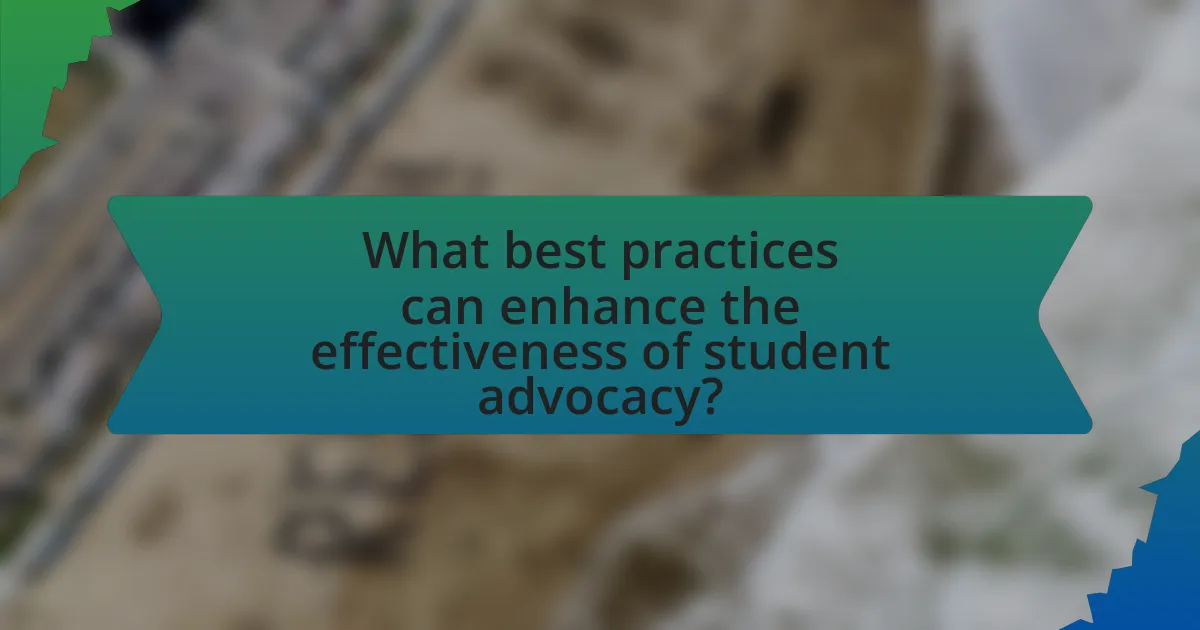
What best practices can enhance the effectiveness of student advocacy?
Effective student advocacy can be enhanced through clear communication, strategic coalition-building, and data-driven approaches. Clear communication ensures that the goals and messages of the advocacy efforts are easily understood by all stakeholders, which is essential for mobilizing support. Strategic coalition-building involves forming alliances with other student organizations, faculty, and community groups to amplify the advocacy efforts and create a broader base of support. Data-driven approaches, such as utilizing surveys and research to present compelling evidence, can strengthen the case for advocacy initiatives by demonstrating the need for change and the potential impact of proposed solutions. These practices collectively contribute to a more organized, persuasive, and impactful advocacy effort.
How can storytelling be used to strengthen advocacy messages?
Storytelling can strengthen advocacy messages by creating emotional connections that resonate with the audience. When narratives are used, they humanize issues, making them relatable and compelling. For instance, a study by the Stanford Graduate School of Business found that stories are 22 times more memorable than facts alone, demonstrating that storytelling enhances retention and engagement. By incorporating personal experiences or testimonials, advocates can illustrate the real-world impact of their cause, thereby motivating action and fostering empathy among supporters.
What techniques can make advocacy narratives more compelling?
Compelling advocacy narratives can be created through techniques such as emotional storytelling, data-driven evidence, and relatable characters. Emotional storytelling engages the audience’s feelings, making the message resonate on a personal level; for instance, narratives that include personal experiences or testimonials can significantly enhance emotional connection. Data-driven evidence supports claims with statistics or research findings, which can increase credibility; for example, using specific data points from studies on student advocacy can illustrate the impact of the issue. Relatable characters, whether real or fictional, help the audience see themselves in the narrative, fostering empathy and understanding; studies show that narratives featuring diverse perspectives can broaden audience engagement and support.
How can personal experiences be integrated into advocacy efforts?
Personal experiences can be integrated into advocacy efforts by using storytelling to create emotional connections and raise awareness about specific issues. This approach allows advocates to share their unique perspectives, making the cause more relatable and compelling to the audience. Research indicates that narratives can significantly influence public opinion and mobilize support; for instance, a study published in the journal “Health Communication” found that personal stories can enhance the effectiveness of health-related advocacy campaigns by increasing empathy and understanding among listeners. By incorporating personal experiences, advocates can effectively engage their audience, foster community support, and drive action towards their cause.
What are the benefits of ongoing training for student advocates?
Ongoing training for student advocates enhances their skills, knowledge, and effectiveness in advocacy efforts. This continuous development allows advocates to stay updated on relevant policies, strategies, and best practices, which is crucial in a rapidly changing educational landscape. For instance, research by the National Association of Student Advocates indicates that trained advocates are 30% more effective in mobilizing peers and influencing policy changes compared to those without ongoing training. Additionally, ongoing training fosters a sense of community and collaboration among advocates, leading to stronger networks and support systems that can amplify their impact.
How can workshops and seminars improve advocacy skills?
Workshops and seminars can significantly improve advocacy skills by providing participants with practical training, networking opportunities, and access to expert knowledge. These structured environments allow individuals to engage in role-playing scenarios, enhancing their ability to communicate effectively and persuasively. Research indicates that experiential learning, such as that found in workshops, leads to a 75% retention rate of skills compared to 5% from traditional lectures. Additionally, seminars often feature experienced advocates who share successful strategies and case studies, further enriching participants’ understanding of effective advocacy techniques. This combination of hands-on practice and expert insights equips individuals with the tools necessary to advocate more effectively in their communities.
What resources are available for student advocacy training?
Resources available for student advocacy training include workshops, online courses, and mentorship programs. Organizations such as the National Student Advocacy Coalition offer comprehensive training sessions that cover essential skills like public speaking, policy analysis, and grassroots organizing. Additionally, platforms like Coursera and edX provide online courses focused on advocacy strategies and civic engagement, allowing students to learn at their own pace. Mentorship programs, often facilitated by universities or local advocacy groups, connect students with experienced advocates who provide guidance and support. These resources collectively equip students with the necessary tools to effectively engage in advocacy efforts.
What practical tips can help sustain momentum in student advocacy?
To sustain momentum in student advocacy, regularly engage stakeholders through consistent communication and collaboration. Establishing a routine of meetings, updates, and feedback sessions fosters a sense of community and shared purpose among advocates. Research indicates that organizations with strong communication strategies are 50% more likely to achieve their goals, highlighting the importance of maintaining dialogue. Additionally, celebrating small victories and recognizing contributions can motivate participants, reinforcing their commitment to the cause. Implementing these strategies creates a sustainable framework for ongoing advocacy efforts.
How can regular events and activities keep students engaged?
Regular events and activities keep students engaged by fostering a sense of community and providing opportunities for active participation. Engaging in these structured experiences allows students to connect with peers, enhancing their social networks and promoting collaboration. Research indicates that students who participate in regular extracurricular activities are more likely to report higher levels of satisfaction and commitment to their educational environment. For instance, a study published in the Journal of Educational Psychology found that students involved in clubs and events demonstrated increased motivation and academic performance, highlighting the positive impact of consistent engagement on their overall educational experience.
What role does recognition play in motivating student advocates?
Recognition plays a crucial role in motivating student advocates by validating their efforts and reinforcing their commitment to advocacy. When student advocates receive acknowledgment for their contributions, it enhances their sense of belonging and purpose within the advocacy community. Research indicates that recognition can lead to increased engagement and persistence; for instance, a study published in the Journal of Educational Psychology found that students who felt recognized for their efforts were more likely to continue participating in advocacy activities. This correlation underscores the importance of recognition as a motivational tool, as it not only boosts self-esteem but also fosters a supportive environment that encourages ongoing involvement in advocacy initiatives.
